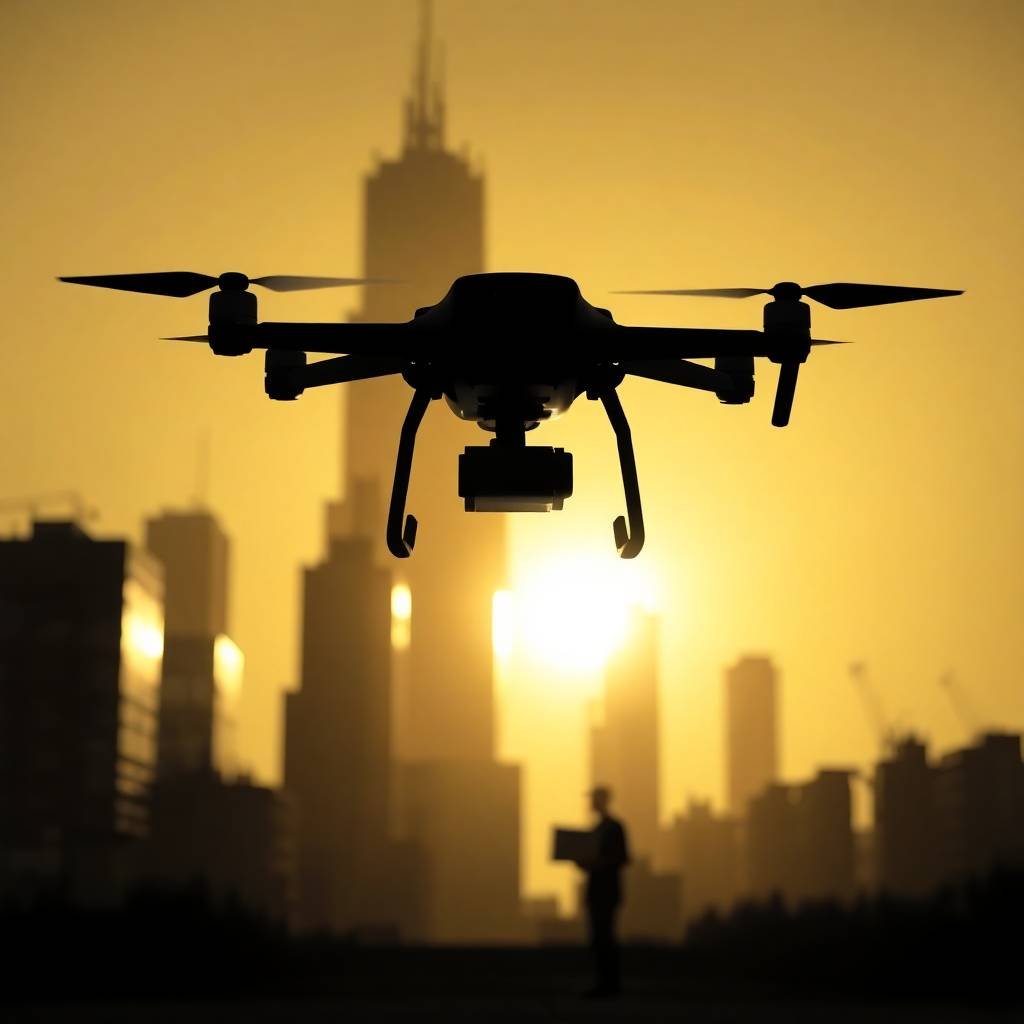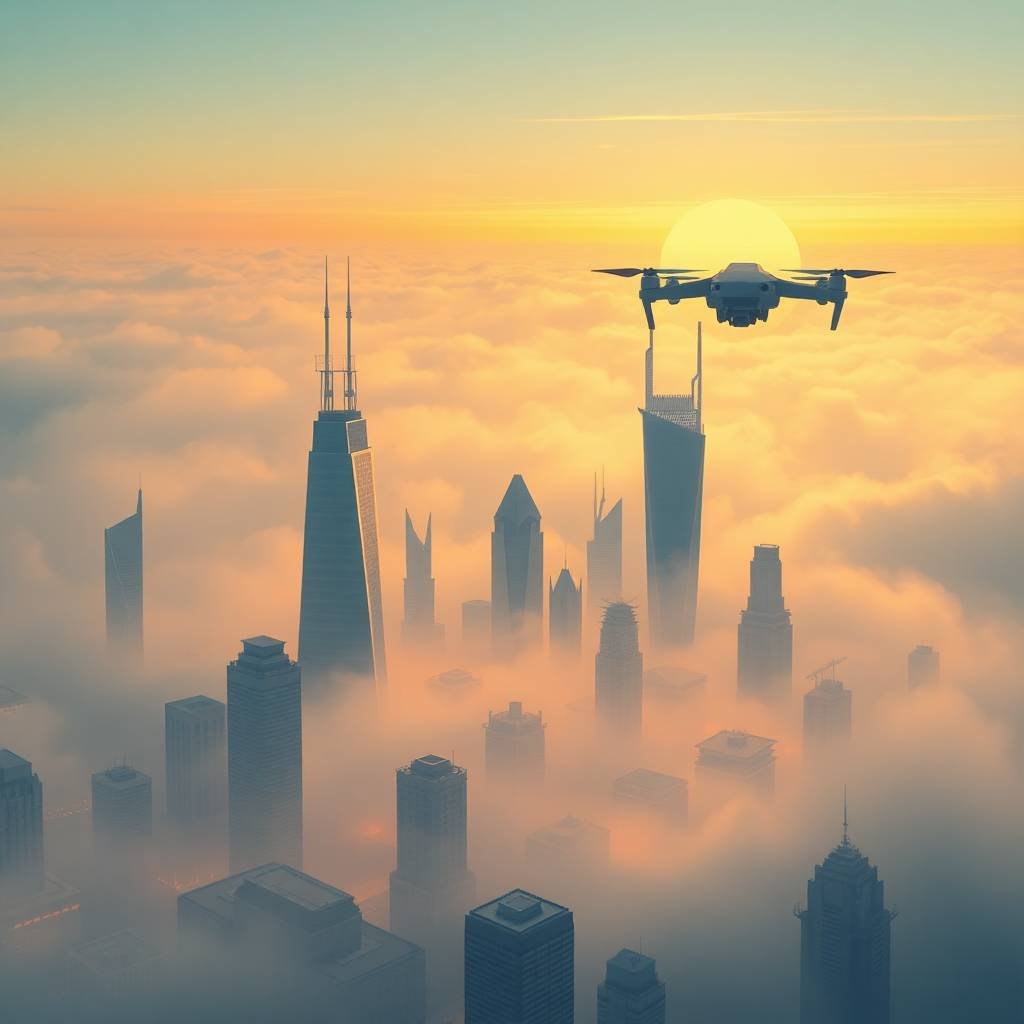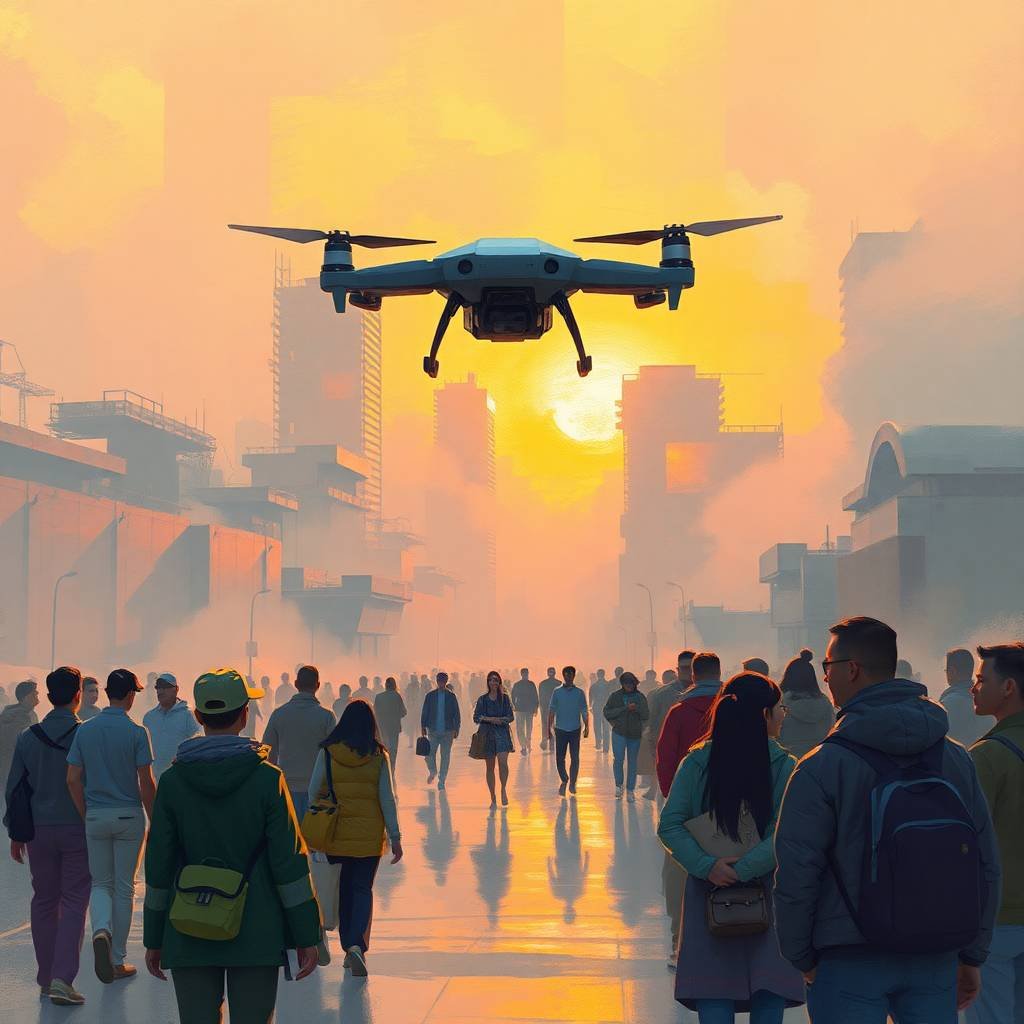1. Speed and Efficiency: Why Drones Outpace Traditional Last-Mile Delivery
In today’s fast-paced world, consumer expectations around delivery have evolved dramatically. With the rise of e-commerce and same-day shipping demands, logistics providers are increasingly turning to innovative solutions. Among the most promising of these is Last‑Mile Drone Delivery, a cutting-edge approach that dramatically enhances delivery speed and efficiency compared to traditional methods.
The Traditional Last-Mile Challenge
The “last mile” refers to the final leg of the delivery journey — from a distribution hub to the customer’s doorstep. Despite being the shortest leg, it is the most complex and expensive. According to the U.S. Department of Transportation, last-mile logistics account for over 50% of total delivery costs in urban areas.
Factors such as traffic congestion, labor shortages, and fluctuating fuel prices contribute to inefficiencies in ground-based delivery. Moreover, rural and hard-to-reach areas pose additional challenges for traditional vehicles. In contrast, Last‑Mile Drone Delivery offers a transformative solution to these systemic hurdles.
How Drones Deliver Superior Speed
Speed is one of the most compelling advantages of Last‑Mile Drone Delivery. Unhindered by traffic or road conditions, drones can fly directly to their destination using the most efficient route possible. This allows them to complete deliveries in a fraction of the time it would take a ground vehicle.
For instance, while a delivery van might take 30–60 minutes to navigate congested city streets, a drone can cover the same distance in under 10 minutes. This advantage becomes even more apparent in emergency situations or when transporting time-sensitive items like medical supplies or essential documents.
Companies like Dynamic 305 are pioneering this movement, offering strategic drone logistics services tailored to urban environments. Businesses can explore their innovative delivery model by scheduling a free consultation.
Efficiency Meets Sustainability
In addition to speed, Last‑Mile Drone Delivery is redefining efficiency. Drones consume significantly less energy per mile than traditional vehicles. With advancements in battery technology and solar charging, many delivery drones now operate with zero carbon emissions, aligning with the White House’s clean energy goals.
This environmental edge makes drones an ideal option for companies aiming to reduce their carbon footprint and appeal to eco-conscious consumers. Furthermore, drones help optimize fleet management, reduce wear and tear on delivery vehicles, and minimize fuel consumption.
Regulatory Support and Infrastructure Growth
The rise of Last‑Mile Drone Delivery is also being supported by evolving regulations. Agencies like the Federal Motor Carrier Safety Administration (FMCSA) and the U.S. Department of Transportation are working closely with industry leaders to establish safety standards and operational guidelines for drone delivery systems.
Urban planning is beginning to accommodate this new mode of transport, with designated landing zones, rooftop hubs, and drone corridors becoming part of smart city infrastructure. These innovations are paving the way for the seamless integration of drones into the logistics ecosystem.
Real-Time Tracking and Customer Satisfaction
Another reason why Last‑Mile Drone Delivery is outpacing traditional methods is the enhanced transparency and control it offers. Real-time tracking enables customers to monitor their packages from dispatch to delivery with pinpoint accuracy. This increased visibility improves customer satisfaction and reduces the number of missed deliveries or package thefts.
Moreover, the ability to deliver directly to balconies, backyards, or secure landing pads offers unmatched convenience. For businesses, this level of precision reduces return rates and operational headaches.
Overcoming Limitations and Looking Ahead
While Last‑Mile Drone Delivery presents numerous advantages, it does come with limitations. Payload capacity is currently limited to lightweight parcels, and adverse weather conditions can impact flight reliability. However, rapid advancements in drone design and AI navigation systems are mitigating these challenges.
As drone fleets become more robust and autonomous, and as 5G networks expand to support real-time data exchange, we can expect drone delivery to become a cornerstone of urban logistics.
Forward-thinking logistics companies, such as Dynamic 305, are already capitalizing on these trends. By offering customized drone delivery solutions, they help clients stay ahead of the curve in an increasingly competitive marketplace. Businesses ready to explore drone integration can book a strategic session with their team of experts.
Conclusion
In the race to improve delivery performance, Last‑Mile Drone Delivery is emerging as a clear frontrunner. With unmatched speed, operational efficiency, environmental benefits, and growing regulatory support, drones are redefining what’s possible in logistics.
As infrastructure and technology continue to advance, and as consumer expectations rise, embracing drone delivery isn’t just a competitive advantage — it’s a necessity. From reducing costs to enhancing customer experience, the shift toward Last‑Mile Drone Delivery marks a new era in transportation and commerce.
For companies looking to lead this transformation, now is the time to act. Reach out to Dynamic 305 or book a discovery call to learn how drone delivery can elevate your operations.

2. Reducing Urban Congestion and Emissions with Airborne Logistics
Urban centers around the world face a common challenge: congestion and pollution caused by inefficient transportation networks, especially in the last leg of delivery. As e-commerce booms, traditional delivery vehicles clog city streets, contributing significantly to traffic and emissions. However, an innovative solution is rising above the gridlock — Last‑Mile Drone Delivery.
The Urban Dilemma: Congestion and Emissions
City streets were not designed for the surge in parcel delivery demands we see today. According to data from the U.S. Department of Transportation, urban freight accounts for nearly 20% of all traffic, yet contributes disproportionately to pollution and delays. Delivery trucks idling in traffic not only burn excessive fuel but also occupy valuable curb space, compounding urban congestion.
The Federal Motor Carrier Safety Administration (FMCSA) has explored various regulatory responses to commercial vehicle overload in cities. Yet, physical infrastructure has limits. To truly revolutionize last-mile logistics, cities must look skyward.
The Sky Solution: Last‑Mile Drone Delivery
Last‑Mile Drone Delivery is emerging as a viable, scalable, and eco-friendly solution to urban logistical challenges. By bypassing ground traffic entirely, drones can deliver packages directly from distribution hubs to consumers’ doors within minutes. Not only does this reduce delivery time and improve customer satisfaction, but it also significantly slashes emissions by replacing fossil-fuel-powered vans with electric aerial systems.
Companies like Dynamic 305 are leading the charge in integrating airborne logistics into urban infrastructure. With customizable drone platforms and intelligent routing systems, they offer sustainable delivery solutions tailored to the needs of modern cities.
Environmental Benefits of Drone-Based Logistics
Transitioning to Last‑Mile Drone Delivery can substantially reduce a city’s carbon footprint. Unlike trucks and vans that rely on gasoline or diesel, most delivery drones are electric, generating zero tailpipe emissions. Over thousands of deliveries, this adds up to a tangible environmental benefit.
According to initiatives promoted by the White House, decarbonizing transportation is a national priority. Airborne logistics directly support this mission by removing a major source of short-distance vehicle pollution from the roads.
Moreover, fewer delivery vehicles on the streets mean reduced wear and tear on infrastructure, fewer traffic accidents, and more space for pedestrians, bikes, and green spaces — reinforcing a city’s commitment to livability and sustainability.
Efficiency Beyond Emissions
Speed is a compelling factor behind the push for Last‑Mile Drone Delivery. In congested urban areas, even short distances can take upwards of 30 minutes by truck. Drones, however, can make the same trip in under 10 minutes. This kind of efficiency is invaluable to sectors like healthcare, where urgent delivery of medication or medical samples can be a matter of life and death.
Dynamic 305 offers consultation for businesses looking to transition to drone-based delivery. Interested stakeholders can schedule a free strategy session to explore drone logistics implementation.
Reducing the Urban Logistics Footprint
The shift toward Last‑Mile Drone Delivery is not just about speed and sustainability — it’s about spatial optimization. Urban warehouses, vertical distribution centers, and drone ports are reshaping how we think about storage and movement in dense environments.
Unlike delivery vans that require large depots and parking infrastructure, drones need minimal ground space. They can launch from rooftops, automated kiosks, or compact hubs, dramatically reducing the logistical footprint within crowded cities.
This decentralization allows for faster response times and reduces the clustering of delivery activity in a few overburdened neighborhoods. By reimagining delivery as a vertical, rather than horizontal, system, cities can better allocate space and resources.
Public and Private Synergy
Implementing Last‑Mile Drone Delivery on a large scale requires thoughtful regulation, robust infrastructure, and public-private collaboration. Government agencies, like the Department of Transportation, are key players in creating guidelines for safe drone operations, air traffic integration, and zoning regulations.
Private companies bring technological innovation and on-the-ground logistics expertise. By working in tandem, both sectors can ensure that drone delivery is not only efficient but also safe, equitable, and compliant with existing transportation frameworks.
Addressing Concerns: Noise, Privacy, and Security
Of course, the rise of Last‑Mile Drone Delivery brings new considerations. Concerns over noise pollution, airspace management, and data privacy must be proactively addressed. Drone delivery firms are responding with quieter designs, geofencing technologies, and end-to-end encryption protocols to maintain user trust and public support.
Municipalities can assist by implementing drone-friendly policies that prioritize quiet zones, define flight paths, and ensure equitable access to services across neighborhoods — avoiding a digital divide in urban logistics.
The Future of Smart Cities
As cities become smarter, so too must their delivery systems. Last‑Mile Drone Delivery aligns perfectly with the vision of intelligent urban ecosystems — where data, mobility, and sustainability converge. Drones can integrate with IoT infrastructure, smart traffic systems, and AI-powered logistics to create dynamic, responsive supply chains.
Urban leaders who embrace drone technology will not only ease traffic and emissions but also enhance public services, create jobs in emerging sectors, and future-proof their cities against rising logistical demand.
Conclusion
Airborne logistics are no longer a futuristic concept — they are an immediate and practical solution to some of urban life’s most pressing challenges. By embracing Last‑Mile Drone Delivery, cities can reduce congestion, lower emissions, and build a smarter, cleaner, and more efficient future. For businesses ready to evolve, Dynamic 305 offers the technology, support, and vision to lead the change.

3. Last‑Mile Drone Delivery: Lowering Operational Costs at Scale
In today’s competitive logistics landscape, reducing operational costs while improving delivery speed is a top priority for businesses. One of the most transformative innovations in this space is Last‑Mile Drone Delivery. As drone technology matures, companies are discovering its power not just in enhancing efficiency but also in significantly lowering costs — particularly when scaled across operations.
The Last Mile: A Costly Bottleneck
The “last mile” — the final leg of a product’s journey from a warehouse to the customer — is notoriously expensive. According to the U.S. Department of Transportation, last-mile delivery can account for more than 50% of total shipping costs. Traditional delivery methods involve fuel expenses, vehicle maintenance, driver wages, and urban congestion penalties, all of which erode profit margins.
Last‑Mile Drone Delivery offers a game-changing alternative. By replacing vans and trucks with agile, battery-powered drones, businesses can bypass many of the logistical and financial challenges plaguing conventional delivery networks.
Lower Fuel and Maintenance Costs
Fuel prices are volatile, and fleets of gas-powered vehicles require constant upkeep. Electric drones, however, run on rechargeable batteries and have fewer moving parts, drastically lowering maintenance requirements. Over time, this reduces the total cost of ownership for delivery fleets.
Companies like Dynamic 305 are pioneering commercial drone platforms that can scale with business needs. These systems are built to operate efficiently in urban and rural environments, allowing organizations to trim recurring fuel and repair expenses.
Minimizing Labor-Intensive Processes
The logistics industry is facing a labor shortage, especially among delivery drivers. Recruiting, training, and retaining personnel are increasingly expensive. Last‑Mile Drone Delivery automates a large portion of the fulfillment process, reducing dependence on human labor for routine deliveries.
While drones won’t replace all delivery jobs, they can handle high-frequency, low-weight packages — the kind that dominate e-commerce. As automation increases, companies can reallocate human resources to higher-value tasks like customer service and complex logistics management.
For business leaders considering a tech transition, Dynamic 305 offers free strategy sessions to help evaluate drone deployment based on current operations and goals.
Scaling Economies with Smart Infrastructure
When implemented at scale, drone delivery unlocks cost-saving synergies. Centralized drone hubs, rooftop landing pads, and automated sorting systems drastically reduce the need for multiple micro-warehouses or distribution centers. This consolidation minimizes real estate and operational overhead.
As cities prepare for next-generation logistics, support from public agencies is critical. The Federal Motor Carrier Safety Administration (FMCSA) and White House initiatives increasingly emphasize sustainable transportation and infrastructure modernization. By aligning with these national objectives, drone programs can often benefit from grants, partnerships, and streamlined regulation pathways.
Energy Efficiency = Long-Term Savings
Energy consumption is a key metric in operational cost calculations. Drones consume a fraction of the energy required by delivery trucks, especially for short urban routes. Their electric batteries are also compatible with solar and renewable charging stations, offering potential for zero-emission operations.
This alignment with green energy goals not only saves money in the long run but also helps meet corporate sustainability targets — an essential factor for ESG-focused investors and customers.
Precision Reduces Waste
Wasted trips, incorrect deliveries, and idle time are hidden cost drivers in traditional logistics. Last‑Mile Drone Delivery platforms rely on GPS tracking, machine learning, and AI-driven logistics routing, allowing for pinpoint accuracy in delivery execution.
This reduces failed delivery attempts, minimizes returns, and improves first-time delivery rates. Over thousands of deliveries, such precision translates into major cost savings and higher customer satisfaction rates.
Regulatory Landscape Supports Innovation
As drone technology scales, so does the legal framework supporting it. Government bodies like the Department of Transportation are working on airspace integration, safety protocols, and commercial drone certifications. These evolving regulations open the door for businesses to adopt drone delivery without fear of non-compliance.
Companies that engage with regulators early, or work with partners like Dynamic 305, can ensure they remain ahead of compliance changes while capturing early-mover advantages.
Data-Driven Optimization
Unlike traditional delivery vehicles, drones collect valuable real-time data during each mission. This includes flight paths, delivery times, weather conditions, and user interaction. Businesses can use this data to fine-tune delivery schedules, manage inventory more effectively, and optimize customer engagement.
Over time, machine learning models can improve cost-efficiency by analyzing thousands of data points — something conventional logistics methods struggle to match.
Flexible Scalability
Another key cost advantage of Last‑Mile Drone Delivery is scalability. Startups can begin with a small fleet serving a specific zip code or customer base, while larger enterprises can deploy hundreds of drones across multiple cities. Scaling does not necessarily require building new facilities — just expanding software and operational bandwidth.
This modularity allows businesses to expand based on demand, keeping costs in check while meeting growing customer expectations.
Conclusion
As competition intensifies in the logistics and e-commerce industries, operational efficiency is no longer optional — it’s essential. Last‑Mile Drone Delivery offers a scalable, sustainable, and cost-effective alternative to outdated ground delivery models. From reducing labor and fuel costs to streamlining infrastructure and minimizing waste, drones are rewriting the cost structure of last-mile logistics.
For companies looking to reduce delivery overhead and future-proof their operations, now is the time to explore airborne logistics. Connect with Dynamic 305 or book a consultation to see how Last‑Mile Drone Delivery can revolutionize your cost structure — one flight at a time..

4. Expanding Delivery Access in Underserved and Hard-to-Reach Areas
In an age where instant delivery is the norm in urban centers, remote and underserved communities often remain an afterthought in traditional logistics models. Rugged terrain, limited infrastructure, and inefficient transportation networks all contribute to a critical access gap. However, Last‑Mile Drone Delivery is transforming this narrative — offering a scalable, cost-effective solution to expand delivery access where it’s needed most.
The Logistics Gap in Hard-to-Reach Areas
Last-mile delivery has always been the most complex and costly stage in the supply chain. For rural, mountainous, or low-income areas, this problem is magnified. Traditional vehicles face road limitations, fuel constraints, and time delays. For example, a single delivery to a remote village may require hours of travel and incur unsustainable costs.
Last‑Mile Drone Delivery disrupts this model by flying over geographical and infrastructural barriers. With autonomous navigation and real-time routing, drones can deliver medicine, food, packages, and even emergency supplies directly to people’s doorsteps — regardless of terrain or traffic.
A New Frontier for Logistics Innovation
Government agencies and private companies are beginning to realize that technology must be leveraged to create a more equitable delivery ecosystem. Agencies like the U.S. Department of Transportation and the Federal Motor Carrier Safety Administration (FMCSA) are updating regulations and safety protocols to accommodate commercial drone use — a vital step toward inclusive infrastructure growth.
Additionally, public-private partnerships are supporting pilot programs in Native American reservations, disaster zones, and underfunded rural counties. These efforts not only increase access but also encourage local workforce development in drone technology.
For businesses and municipalities interested in assessing drone readiness and strategy, Dynamic 305 offers tailored consultations to guide implementation and scaling.
How Last‑Mile Drone Delivery Closes the Access Gap
The fundamental benefit of Last‑Mile Drone Delivery is its ability to reach areas where traditional delivery methods falter. This is especially crucial in regions with:
- Limited road access
- Disaster-prone zones
- Aging infrastructure
- Sparse population density
By reducing reliance on vehicles and physical infrastructure, drones can create consistent, timely delivery schedules in places that were previously underserved. This capability is essential for transporting time-sensitive items like medical prescriptions, perishable goods, and educational materials.
Cost-Effective Delivery at Scale
Another key advantage is cost reduction. In rural settings, the per-unit delivery cost for ground transportation is significantly higher than in cities due to fuel, labor, and maintenance. Last‑Mile Drone Delivery flips this cost model.
Battery-powered drones can complete multiple deliveries per charge, and require far less maintenance than traditional delivery fleets. Over time, these savings add up — especially when scaled across hundreds or thousands of deliveries per month.
By working with drone logistics experts like Dynamic 305, organizations can implement drone delivery systems that are cost-efficient from day one, and scalable as demand grows.
Health, Equity, and Economic Empowerment
Access to delivery is more than a matter of convenience — it’s a public health and equity issue. In underserved communities, access to essentials like clean water, medication, and infant supplies can be inconsistent or delayed due to infrastructure bottlenecks. In emergencies, this delay can be life-threatening.
Last‑Mile Drone Delivery can ensure critical supplies arrive quickly, reliably, and without the need for traditional transportation routes. For instance, after natural disasters or during extreme weather, drones are often the first viable delivery method available.
On a broader scale, improved access stimulates local economies. Small businesses in remote areas can ship products faster, hospitals can receive equipment more efficiently, and residents can engage in e-commerce just like their urban counterparts.
Policy Momentum and Federal Support
National conversations around equity and infrastructure have increased federal interest in airborne logistics. The White House has emphasized the importance of reducing regional disparities in access to goods and services, which includes support for technology-driven solutions like drones.
With clear policy goals around sustainability and innovation, there is growing alignment between drone logistics and federal funding priorities. As drone infrastructure becomes part of the national transportation conversation, businesses can benefit from grants, tax incentives, and regulatory fast-tracking.
Organizations that align their efforts with these government objectives can gain both financial support and social credibility — particularly if they prioritize delivery access in marginalized communities.
Building Local Capacity Through Drone Operations
An often-overlooked benefit of drone deployment is the opportunity to train and employ local residents as drone pilots, maintenance technicians, and operations managers. This not only ensures the sustainability of Last‑Mile Drone Delivery in remote areas but also provides new job opportunities in the tech and logistics sectors.
Training programs led by drone logistics firms and educational partners can jumpstart community engagement and create a pipeline for workforce development. With rising interest in STEM careers, drone delivery projects serve as both practical and inspirational platforms for youth engagement.
Conclusion
Equity in delivery access is no longer just an aspiration — it’s achievable through scalable, efficient solutions like Last‑Mile Drone Delivery. By overcoming physical barriers, reducing operational costs, and integrating with national infrastructure goals, drones have the power to revolutionize how and where goods are delivered.
For underserved and hard-to-reach areas, the future of delivery is in the sky — and it’s arriving faster than we imagined.
Explore how drone logistics can serve your community or business by visiting Dynamic 305 or booking a strategy call today.

5. Boosting Customer Satisfaction Through Real-Time Precision
In today’s experience-driven economy, customer expectations for speed, transparency, and convenience are higher than ever. Whether it’s groceries, medical supplies, or e-commerce orders, the last stretch of a delivery—often the most complex—is critical to the end-user experience. Enter Last‑Mile Drone Delivery: a groundbreaking innovation revolutionizing real-time logistics and dramatically boosting customer satisfaction.
Why Real-Time Precision Matters in the Last Mile
Customer loyalty often hinges on the final touchpoint: delivery. Delays, vague time windows, and missed drop-offs can break trust quickly. Real-time precision—knowing exactly where a package is and when it will arrive—is more than a convenience; it’s a competitive necessity.
Last‑Mile Drone Delivery excels in this domain. Drones utilize GPS navigation, automated route optimization, and IoT sensors to deliver with pinpoint accuracy. Customers receive live updates and exact arrival times, transforming uncertainty into assurance. This level of precision not only elevates the delivery experience but also reduces missed deliveries and reattempt costs.
The Customer-Centric Benefits of Last‑Mile Drone Delivery
One of the most tangible benefits of Last‑Mile Drone Delivery is its consistency. Drones operate on predictable schedules and are unaffected by road traffic, construction detours, or labor shortages. For customers, this means:
- Reduced delivery windows (from hours to minutes)
- Live tracking and ETAs
- Fewer failed deliveries
- Greater trust and brand loyalty
This is especially impactful in dense urban environments or gated communities where traditional vehicles may struggle to access drop-off points efficiently.
If your business is exploring how to integrate drone logistics into your supply chain, Dynamic 305 provides consulting services and deployment support tailored to your customer base and infrastructure. You can schedule a strategic session here.
Hyper-Personalized Delivery Experiences
Personalization has become a key pillar of modern customer service. Last‑Mile Drone Delivery supports hyper-local and hyper-personalized logistics. Unlike traditional fleets that often batch deliveries, drones can make direct-to-door flights customized by time, location, and customer preferences.
Imagine a customer scheduling a same-day delivery window for a prescription or dinner ingredients. A drone can fulfill the request within a 15-minute window—precision that enhances both convenience and satisfaction. These personalized deliveries build deeper emotional connections with a brand, translating into higher retention and repeat purchases.
Real-Time Feedback Loops and System Optimization
What sets Last‑Mile Drone Delivery apart from traditional methods isn’t just the delivery vehicle—it’s the feedback mechanisms. Drones collect environmental data, optimize flight paths in real time, and provide actionable delivery metrics.
This means businesses can:
- Analyze customer satisfaction tied to delivery speed
- Identify geographic bottlenecks or challenges
- Automate adjustments to delivery routes and times
- Ensure compliance with evolving regulations via platforms like the U.S. Department of Transportation and the Federal Motor Carrier Safety Administration
Incorporating drones into the last-mile not only provides customers with unmatched service—it helps businesses optimize logistics, lower costs, and improve operational agility.
Government Support and Regulatory Alignment
Adopting drone technology is no longer a fringe investment. With growing support from national agencies and bipartisan policy frameworks, Last‑Mile Drone Delivery is becoming a cornerstone of future-ready infrastructure.
Agencies like the White House are promoting equitable, tech-enabled infrastructure that enhances service delivery across all demographics. Aligning your logistics strategy with these priorities opens access to innovation grants, regulatory guidance, and public-private pilot programs.
Dynamic 305 stays ahead of these policy shifts, offering clients guidance on compliance, opportunity mapping, and integration strategies that align with federal goals.
Drone Deliveries in Emergency and High-Need Scenarios
In situations where time is critical—natural disasters, medical emergencies, or supply chain disruptions—Last‑Mile Drone Delivery becomes a lifesaver. Imagine a drone carrying emergency insulin to a senior in a flood-affected zone within 15 minutes, bypassing blocked roads and gridlock.
Precision in such scenarios doesn’t just improve satisfaction—it can save lives. These applications are gaining traction across humanitarian, public health, and government agencies. Companies that invest in these capabilities now will be prepared to meet high-impact delivery needs when they arise.
Building a Last-Mile Advantage Through Innovation
The customer experience doesn’t end when a product is ordered—it ends when that product is received on time, undamaged, and with a sense of ease. Last‑Mile Drone Delivery enables companies to own that final impression and turn it into a competitive edge.
Whether you’re a logistics company, healthcare provider, or e-commerce retailer, integrating drone delivery is more than a trend—it’s a strategic upgrade. With tools like predictive analytics, geofencing, and real-time notifications, drones enable a higher standard of delivery performance.
For teams exploring these technologies, Dynamic 305 offers hands-on consultation to assess viability, cost, and long-term ROI. You can book a 30-minute consultation here to get started.
Conclusion: A Skyward Shift in Customer Experience
As customer expectations evolve, businesses must adopt solutions that deliver reliability, speed, and transparency. Last‑Mile Drone Delivery meets these demands head-on, offering real-time precision that turns logistics into a customer satisfaction engine.
By integrating drones into your last-mile strategy, you’re not just improving delivery—you’re elevating the customer experience, building brand trust, and staying ahead of competitors in a digital-first economy.
Want to learn how Last‑Mile Drone Delivery can boost satisfaction and retention for your organization? Visit Dynamic 305 or book a strategy session today.

6. Resilience in Crisis: Drone Deliveries During Natural Disasters and Pandemics
In an increasingly unpredictable world, resilience is no longer a luxury—it’s a necessity. The COVID-19 pandemic and a rising number of climate-related disasters have exposed vulnerabilities in traditional logistics systems. From medical supply chain breakdowns to delayed aid in flood-ravaged regions, communities and businesses alike have struggled with last-mile inefficiencies. This is where Last‑Mile Drone Delivery emerges as a transformative solution.
When roads are impassable or human contact must be minimized, drones offer a secure, fast, and reliable alternative. Their ability to bypass ground infrastructure makes them uniquely suited for crisis response, enhancing both public safety and service continuity.
How Drones Are Redefining Emergency Logistics
In times of disaster, traditional logistics often falter. Flooded roads, downed bridges, and damaged infrastructure can bring ground transportation to a standstill. Last‑Mile Drone Delivery sidesteps these limitations by leveraging aerial routes, delivering critical supplies directly to affected zones without delay.
During the pandemic, drones successfully delivered vaccines, testing kits, and essential medications to rural and quarantined communities. Organizations using drones reported drastically reduced delivery times and minimized human exposure. According to the U.S. Department of Transportation, integrating unmanned aerial vehicles into crisis response has become a federal priority.
For businesses and municipalities aiming to prepare for the next crisis, Dynamic 305 offers tailored strategies to implement drone logistics at scale. Book a 30-minute consultation to explore your options.
Fast, Contactless, and Scalable Solutions
One of the defining advantages of Last‑Mile Drone Delivery in crisis settings is its speed. Drones can fly over obstacles, avoid traffic, and reach hard-to-access areas within minutes. For example, during hurricanes or wildfires, when seconds can mean the difference between life and death, drones can deliver EpiPens, water filters, or communications devices to stranded individuals quickly.
Moreover, drones offer contactless delivery, which became crucial during the pandemic. By eliminating the need for person-to-person exchange, they protect both couriers and recipients—a factor emphasized in recent health and safety protocols from the Federal Motor Carrier Safety Administration (FMCSA).
Government and Infrastructure Support
The growing use of Last‑Mile Drone Delivery in emergency scenarios has captured the attention of policymakers. Federal initiatives are supporting public-private collaborations to advance drone delivery networks in alignment with national infrastructure goals. In fact, the White House has emphasized the importance of modernizing logistics to support equitable and disaster-resilient service delivery.
With shifting regulations and federal funding opportunities becoming more accessible, now is the ideal time for cities and companies to align their plans with national objectives. Partnering with expert consultants like Dynamic 305 ensures you’re on the leading edge of compliance and innovation.
Supporting Vulnerable and Remote Communities
Crisis conditions tend to hit the most vulnerable the hardest. Isolated rural areas, underserved communities, and people with mobility challenges are often last in line for aid. Last‑Mile Drone Delivery helps reverse that trend.
Drones are capable of reaching remote villages, mountaintops, islands, or areas disconnected from the main grid. They can deliver everything from food and baby formula to medications and emergency tools—making a tangible difference where conventional logistics fail.
By democratizing access to essential services, drones not only provide short-term relief but also contribute to long-term resilience planning. This equity-driven approach is central to federal and local infrastructure investment priorities.
Minimizing Environmental Impact in Crisis Response
Crisis logistics can be environmentally taxing. Helicopters, diesel trucks, and generators contribute to emissions and noise pollution—often in already devastated areas. In contrast, Last‑Mile Drone Delivery operates on electric power and has a significantly lower environmental footprint.
This clean alternative aligns with broader sustainability goals promoted by federal agencies. As part of the climate-resilient infrastructure push, integrating drones into logistics workflows supports both environmental and humanitarian missions.
Businesses aiming to strengthen their sustainability credentials while preparing for future disruptions can learn more through Dynamic 305’s strategy sessions.
Real-World Case Studies: Proof of Concept
Recent real-world deployments have underscored the power of Last‑Mile Drone Delivery during crises:
- In Africa, drones delivered blood and vaccines across mountainous regions inaccessible by car.
- In the U.S., drones assisted in delivering PPE to hospitals during peak pandemic waves.
- In hurricane-prone regions, local governments piloted drone corridors to ensure uninterrupted delivery of emergency rations and medical supplies.
These examples reflect a growing consensus: when traditional logistics are blocked, drones offer a scalable, resilient, and life-saving alternative.
Planning for the Next Crisis—Today
Waiting for the next disaster is not an option. Future-ready businesses and municipalities are proactively integrating Last‑Mile Drone Delivery into their resilience strategies. From deploying local drone hubs to training operators and securing FAA approval, the time to build is now.
Organizations can start small with pilot programs and scale quickly as technology, policy, and infrastructure mature. Working with expert partners like Dynamic 305 can streamline the process, from feasibility analysis to live deployment. Schedule a 30-minute consult to begin mapping your path to crisis resilience.
Conclusion: Drones as a Backbone of Crisis Resilience
In the face of escalating natural disasters and health emergencies, agility is the key to resilience. Last‑Mile Drone Delivery is no longer an experimental idea—it is a proven, scalable, and essential component of modern crisis response.
By embracing this technology, organizations not only protect lives but also build systems that can withstand future shocks. The future of disaster logistics is airborne, and those who act now will lead in times of need.

7. Future-Proofing Urban Logistics with Scalable Drone Infrastructure
As urban populations swell and e-commerce continues its rapid ascent, the demand for efficient, sustainable, and resilient delivery solutions has never been greater. Traditional logistics models are increasingly strained, leading to congestion, delays, and elevated emissions. Enter Last‑Mile Drone Delivery—a transformative approach poised to redefine urban logistics by offering scalable, agile, and eco-friendly solutions.
The Imperative for Scalable Drone Infrastructure
Urban centers are grappling with the challenges of delivering goods swiftly and sustainably. Last‑Mile Drone Delivery addresses these issues by:
- Reducing Traffic Congestion: By taking to the skies, drones alleviate pressure on overburdened road networks.
- Enhancing Delivery Speed: Drones can bypass ground-level obstacles, ensuring faster deliveries.
- Lowering Environmental Impact: Electric-powered drones contribute to reduced carbon emissions.
However, to fully realize these benefits, cities must invest in scalable drone infrastructure, including designated air corridors, landing zones, and regulatory frameworks that support widespread drone operations.
Regulatory Landscape and Government Initiatives
The successful integration of Last‑Mile Drone Delivery into urban logistics hinges on supportive policies and regulations. Federal agencies are actively shaping the drone delivery landscape:
- The U.S. Department of Transportation is developing guidelines to ensure the safe integration of drones into national airspace.
- The Federal Motor Carrier Safety Administration (FMCSA) is exploring the implications of drone deliveries on existing transportation systems.
- The White House has highlighted the role of advanced technologies, including drones, in modernizing infrastructure and promoting economic growth.
Engaging with these regulatory bodies is crucial for stakeholders aiming to implement drone delivery solutions effectively.
Building the Physical and Digital Infrastructure
Implementing Last‑Mile Drone Delivery requires a dual focus on physical and digital infrastructure:
- Physical Infrastructure: Establishing drone ports, charging stations, and maintenance facilities within urban areas.
- Digital Infrastructure: Developing robust communication networks, air traffic management systems, and cybersecurity protocols to ensure safe and efficient drone operations.
Companies like Dynamic 305 specialize in designing and deploying comprehensive drone infrastructure solutions tailored to urban environments. Schedule a consultation to explore how your city or business can benefit from scalable drone logistics.
Economic and Environmental Benefits
Adopting Last‑Mile Drone Delivery offers significant economic and environmental advantages:
- Cost Savings: Drones reduce the need for large delivery fleets and associated labor costs.
- Increased Efficiency: Faster deliveries enhance customer satisfaction and operational efficiency.
- Sustainability: Electric drones contribute to lower greenhouse gas emissions and reduced reliance on fossil fuels.
These benefits align with broader goals of creating smart, sustainable cities that prioritize both economic vitality and environmental stewardship.
Overcoming Challenges and Ensuring Equity
While the potential of Last‑Mile Drone Delivery is immense, challenges remain:
- Regulatory Hurdles: Navigating complex airspace regulations and obtaining necessary approvals.
- Public Acceptance: Addressing concerns related to privacy, noise, and safety.
- Equity Considerations: Ensuring that drone delivery services are accessible to all communities, including underserved areas.
Collaborative efforts among government agencies, private sector partners, and community stakeholders are essential to address these challenges and promote equitable access to drone delivery services.
The Path Forward
The integration of Last‑Mile Drone Delivery into urban logistics is not a question of if, but when. As technology advances and regulatory frameworks evolve, cities and businesses must proactively plan for this shift. Key steps include:
- Stakeholder Engagement: Collaborate with policymakers, industry leaders, and community members to build consensus and address concerns.
- Infrastructure Investment: Allocate resources to develop the necessary physical and digital infrastructure.
- Pilot Programs: Implement small-scale drone delivery projects to test feasibility and gather data.
- Policy Development: Work with regulatory bodies to establish clear guidelines and standards for drone operations.
By taking these proactive measures, urban centers can position themselves at the forefront of a logistics revolution that promises to enhance efficiency, sustainability, and resilience.
Conclusion
Last‑Mile Drone Delivery represents a pivotal advancement in urban logistics, offering scalable solutions to meet the growing demands of modern cities. By investing in the necessary infrastructure and fostering collaborative partnerships, stakeholders can unlock the full potential of drone technology to create smarter, more sustainable urban environments.
For expert guidance on implementing scalable drone infrastructure in your city or organization, contact Dynamic 305 or schedule a consultation today.
